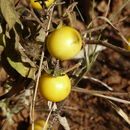Distribution in Egypt
provided by Bibliotheca Alexandrina LifeDesk
Nile region and Gebel Elba.
- author
- BA Cultnat
- provider
- Bibliotheca Alexandrina
Global Distribution
provided by Bibliotheca Alexandrina LifeDesk
Egypt, southwest Asia, drier parts of tropical Africa.
- author
- BA Cultnat
- provider
- Bibliotheca Alexandrina
Comments
provided by eFloras
Fairly common in the plains and the lower hills up to 1400 m. The plant parts are said to be medicinal, being used as a remedy for toothache, sore throats and in chest complaints.
- license
- cc-by-nc-sa-3.0
- copyright
- Missouri Botanical Garden, 4344 Shaw Boulevard, St. Louis, MO, 63110 USA
Description
provided by eFloras
Shrub up to 120 cm tall. Stems and branches yellowish-green with dense stellate tomentum and prickly; prickles conical, up to 8 mm long, straight or curved, yellow. Leaves 3.5-8 x 2.5-6.5 cm, ovate to broadly ovate, sinuate, grayish-green dense stellately hairy, veins with a few prickles. Peduncles 10-20 mm long, often paired; one bearing bisexual flowers and the other a short raceme of (2-) 3-5 male flowers. Flowers purple-blue. Pedicel and calyx stellately tomentose and sparsely prickled. Calyx 6-7 mm long, often thickened in fruit. Corolla limb 3-3.5 cm broad; lobes triangular, 9-11 mm long, dense stellate-tomentose, sparsely so within. Anthers 5-6 mm long, elongated. Style and ovary glabrescent. Berry globose, 25-30 mm long, yellow. Seeds ± 2.5 mm broad, subreniform, minutely reticulate-rugose, pale- brown.
- license
- cc-by-nc-sa-3.0
- copyright
- Missouri Botanical Garden, 4344 Shaw Boulevard, St. Louis, MO, 63110 USA
Distribution
provided by eFloras
Distribution: Iran, Syria, Egypt, Ethiopia, Sudan, Arabia, Pakistan and India.
- license
- cc-by-nc-sa-3.0
- copyright
- Missouri Botanical Garden, 4344 Shaw Boulevard, St. Louis, MO, 63110 USA
Flower/Fruit
provided by eFloras
Fl. Per.: mostly throughout the year.
- license
- cc-by-nc-sa-3.0
- copyright
- Missouri Botanical Garden, 4344 Shaw Boulevard, St. Louis, MO, 63110 USA
Derivation of specific name
provided by Flora of Zimbabwe
incanum: hoary, white
- license
- cc-by-nc
- copyright
- Mark Hyde, Bart Wursten and Petra Ballings
- bibliographic citation
- Hyde, M.A., Wursten, B.T. and Ballings, P. (2002-2014). Solanum incanum L. Flora of Zimbabwe website. Accessed 28 August 2014 at http://www.zimbabweflora.co.zw/speciesdata/species.php?species_id=150670
- author
- Mark Hyde
- author
- Bart Wursten
- author
- Petra Ballings
Description
provided by Flora of Zimbabwe
Herbaceous or soft wooded shrub, 0.5 to 3 m. A very variable species, which may be armed on most parts, including the leaves, or may occasionally be unarmed. Stems and undersides of leaves may be densely covered in a whitish felt of stellate hairs, turning glabrescent with age. Leaves from lanceolate to broadly ovate; margin entire to deeply lobed with broadly triangular or rounded lobes; prickles on the midrib and lateal veins may or may not be present. Flowers in clusters along the branches, sometimes axillary or leaf-opposed; corolla pale to deep blue, mauve or purple, occasionally white, 1.5 cm in diameter, fragrant. Fruit spherical, green, often striped or mottled with white, turning yellow to orange-brown when ripe.
- license
- cc-by-nc
- copyright
- Mark Hyde, Bart Wursten and Petra Ballings
- bibliographic citation
- Hyde, M.A., Wursten, B.T. and Ballings, P. (2002-2014). Solanum incanum L. Flora of Zimbabwe website. Accessed 28 August 2014 at http://www.zimbabweflora.co.zw/speciesdata/species.php?species_id=150670
- author
- Mark Hyde
- author
- Bart Wursten
- author
- Petra Ballings
Frequency
provided by Flora of Zimbabwe
Common
- license
- cc-by-nc
- copyright
- Mark Hyde, Bart Wursten and Petra Ballings
- bibliographic citation
- Hyde, M.A., Wursten, B.T. and Ballings, P. (2002-2014). Solanum incanum L. Flora of Zimbabwe website. Accessed 28 August 2014 at http://www.zimbabweflora.co.zw/speciesdata/species.php?species_id=150670
- author
- Mark Hyde
- author
- Bart Wursten
- author
- Petra Ballings
Worldwide distribution
provided by Flora of Zimbabwe
Of unknown origin, but now widespread throughout the paleotropics.
- license
- cc-by-nc
- copyright
- Mark Hyde, Bart Wursten and Petra Ballings
- bibliographic citation
- Hyde, M.A., Wursten, B.T. and Ballings, P. (2002-2014). Solanum incanum L. Flora of Zimbabwe website. Accessed 28 August 2014 at http://www.zimbabweflora.co.zw/speciesdata/species.php?species_id=150670
- author
- Mark Hyde
- author
- Bart Wursten
- author
- Petra Ballings
Solanum incanum
provided by wikipedia EN
Solanum incanum is a species of nightshade, a flowering plant in the family Solanaceae. It is native to Sub-Saharan Africa and the Middle East, eastwards to India. The species was introduced to Taiwan and Vietnam.[3]
Common names include thorn apple, bitter apple,[1] bitterball [4] and bitter tomato [5][6] It may be confused with the similar S. linnaeanum where their ranges overlap in Africa. In ancient India, Solanum incanum was domesticated into the eggplant, Solanum melongena.[7][8][9] In biblical literature, it is sometimes used as a "hedge of thorns" (Hebrew: מְשֻׂכַת חָדֶק).[10]
Gallery
References

- license
- cc-by-sa-3.0
- copyright
- Wikipedia authors and editors
Solanum incanum: Brief Summary
provided by wikipedia EN
Solanum incanum is a species of nightshade, a flowering plant in the family Solanaceae. It is native to Sub-Saharan Africa and the Middle East, eastwards to India. The species was introduced to Taiwan and Vietnam.
Common names include thorn apple, bitter apple, bitterball and bitter tomato It may be confused with the similar S. linnaeanum where their ranges overlap in Africa. In ancient India, Solanum incanum was domesticated into the eggplant, Solanum melongena. In biblical literature, it is sometimes used as a "hedge of thorns" (Hebrew: מְשֻׂכַת חָדֶק).
- license
- cc-by-sa-3.0
- copyright
- Wikipedia authors and editors

